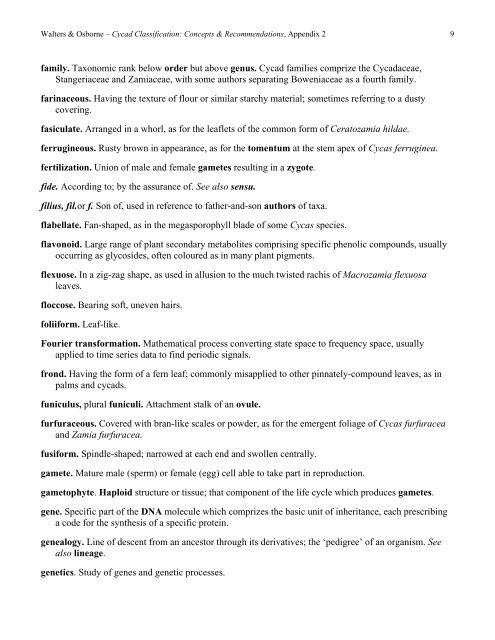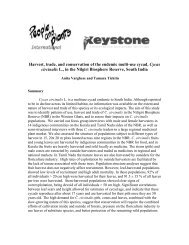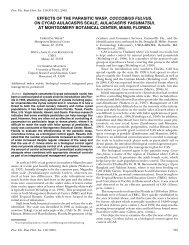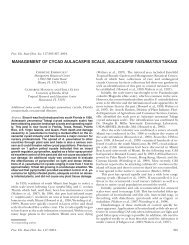Glossary of terms used in cycad systematics - Cycad Specialist Group
Glossary of terms used in cycad systematics - Cycad Specialist Group
Glossary of terms used in cycad systematics - Cycad Specialist Group
Create successful ePaper yourself
Turn your PDF publications into a flip-book with our unique Google optimized e-Paper software.
Walters & Osborne – <strong>Cycad</strong> Classification: Concepts & Recommendations, Appendix 2 9<br />
family. Taxonomic rank below order but above genus. <strong>Cycad</strong> families comprize the <strong>Cycad</strong>aceae,<br />
Stangeriaceae and Zamiaceae, with some authors separat<strong>in</strong>g Boweniaceae as a fourth family.<br />
far<strong>in</strong>aceous. Hav<strong>in</strong>g the texture <strong>of</strong> flour or similar starchy material; sometimes referr<strong>in</strong>g to a dusty<br />
cover<strong>in</strong>g.<br />
fasiculate. Arranged <strong>in</strong> a whorl, as for the leaflets <strong>of</strong> the common form <strong>of</strong> Ceratozamia hildae.<br />
ferrug<strong>in</strong>eous. Rusty brown <strong>in</strong> appearance, as for the tomentum at the stem apex <strong>of</strong> Cycas ferrug<strong>in</strong>ea.<br />
fertilization. Union <strong>of</strong> male and female gametes result<strong>in</strong>g <strong>in</strong> a zygote.<br />
fide. Accord<strong>in</strong>g to; by the assurance <strong>of</strong>. See also sensu.<br />
filius, fil.or f. Son <strong>of</strong>, <strong>used</strong> <strong>in</strong> reference to father-and-son authors <strong>of</strong> taxa.<br />
flabellate. Fan-shaped, as <strong>in</strong> the megasporophyll blade <strong>of</strong> some Cycas species.<br />
flavonoid. Large range <strong>of</strong> plant secondary metabolites compris<strong>in</strong>g specific phenolic compounds, usually<br />
occurr<strong>in</strong>g as glycosides, <strong>of</strong>ten coloured as <strong>in</strong> many plant pigments.<br />
flexuose. In a zig-zag shape, as <strong>used</strong> <strong>in</strong> allusion to the much twisted rachis <strong>of</strong> Macrozamia flexuosa<br />
leaves.<br />
floccose. Bear<strong>in</strong>g s<strong>of</strong>t, uneven hairs.<br />
foliiform. Leaf-like.<br />
Fourier transformation. Mathematical process convert<strong>in</strong>g state space to frequency space, usually<br />
applied to time series data to f<strong>in</strong>d periodic signals.<br />
frond. Hav<strong>in</strong>g the form <strong>of</strong> a fern leaf; commonly misapplied to other p<strong>in</strong>nately-compound leaves, as <strong>in</strong><br />
palms and <strong>cycad</strong>s.<br />
funiculus, plural funiculi. Attachment stalk <strong>of</strong> an ovule.<br />
furfuraceous. Covered with bran-like scales or powder, as for the emergent foliage <strong>of</strong> Cycas furfuracea<br />
and Zamia furfuracea.<br />
fusiform. Sp<strong>in</strong>dle-shaped; narrowed at each end and swollen centrally.<br />
gamete. Mature male (sperm) or female (egg) cell able to take part <strong>in</strong> reproduction.<br />
gametophyte. Haploid structure or tissue; that component <strong>of</strong> the life cycle which produces gametes.<br />
gene. Specific part <strong>of</strong> the DNA molecule which comprizes the basic unit <strong>of</strong> <strong>in</strong>heritance, each prescrib<strong>in</strong>g<br />
a code for the synthesis <strong>of</strong> a specific prote<strong>in</strong>.<br />
genealogy. L<strong>in</strong>e <strong>of</strong> descent from an ancestor through its derivatives; the ‘pedigree’ <strong>of</strong> an organism. See<br />
also l<strong>in</strong>eage.<br />
genetics. Study <strong>of</strong> genes and genetic processes.






